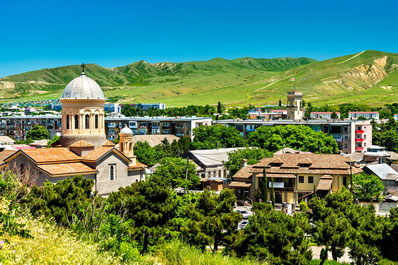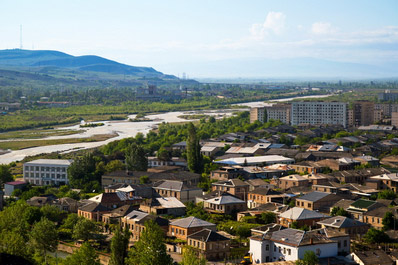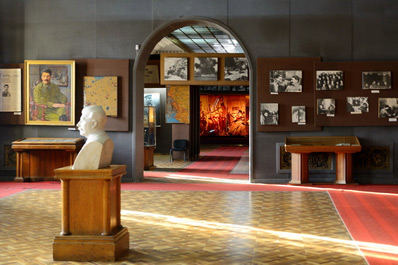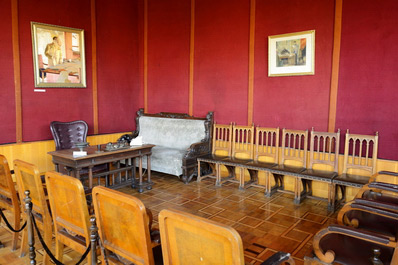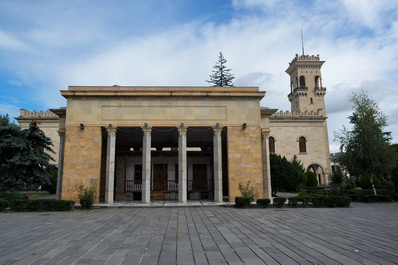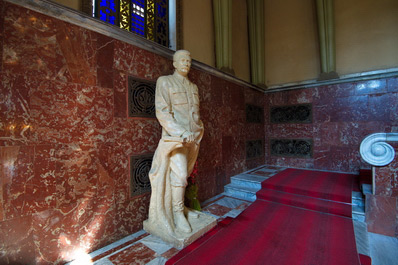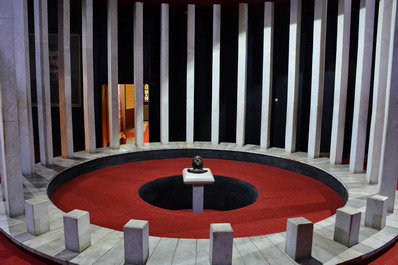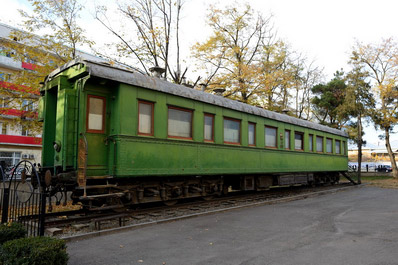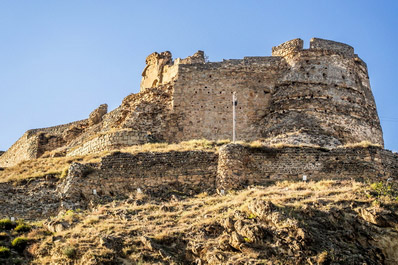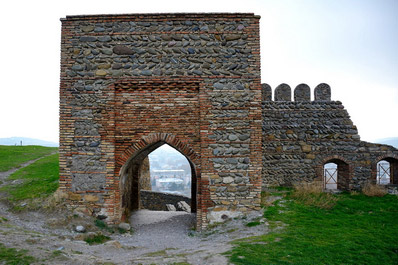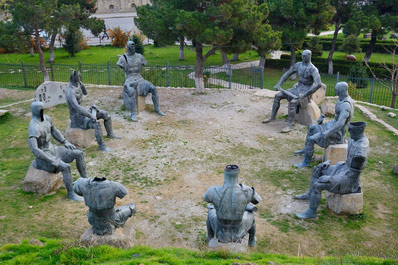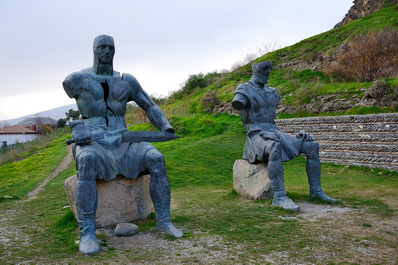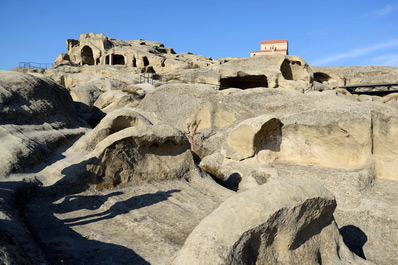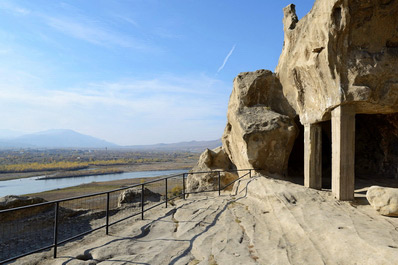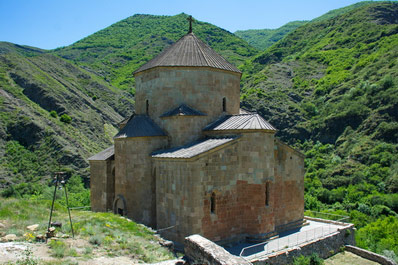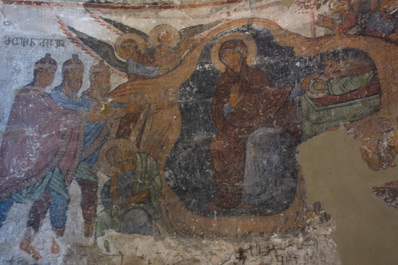Gori, Georgia
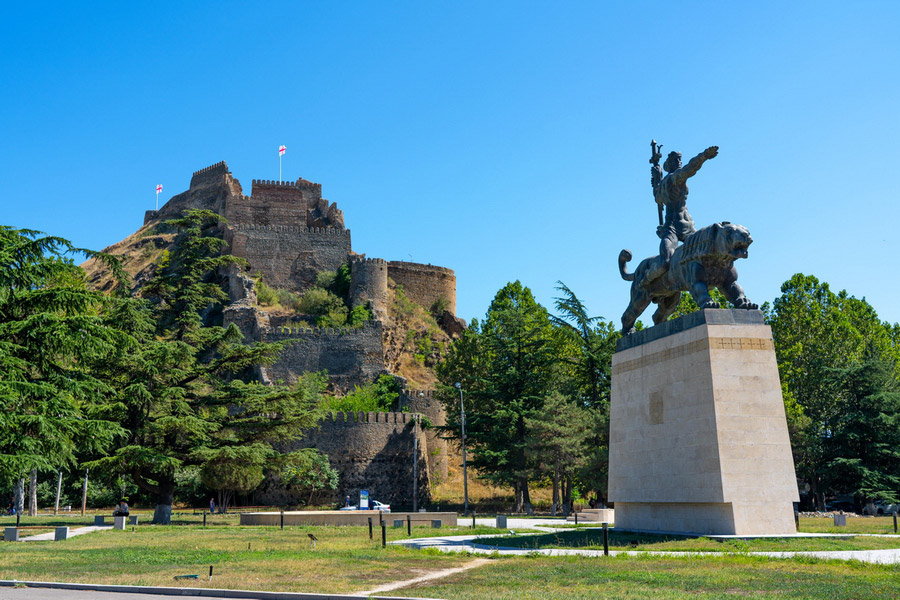
Altitude: from 588 meters above sea level
Official language: Georgian
Popular languages: Russian
Nationality: Georgians, Russians, Armenians, Ukrainians, Jews
Time zone: UTC+4
Phone code: +995 370
Postal code: 14ХХ
Vehicle code: GEO
The quaint Georgian city of Gori, home to fewer than 50,000 people, draws crowds of tourists annually, eager to explore the sites that have garnered it global fame. While widely recognized as the birthplace of Stalin, many are unaware of Gori's rich history as one of Georgia's oldest settlements. Historical references to Gori date back to the 12th century, but it's believed that the city's origins may extend even further, possibly to the 7th century, as suggested by many historians.
Strolling through Gori is a delightful experience, marked by its exquisite architecture — grand, monumental buildings from the Soviet era. The city's romantic streetscape, whether bathed in the glow of street lamps or the early morning sun, invites leisurely walks. The Goritsikhe fortress, a highlight of the city, offers breathtaking 360-degree views. For a taste of the local culture, the city's restaurants serve excellent Georgian wine and hearty Georgian cuisine. Our comprehensive guide to Gori ensures you won't miss any of its fascinating attractions.
How to get to Gori?
Getting to Gori is quite straightforward. The most convenient options are taking a private car, a taxi, or a marshrutka (minibus) from Tbilisi. The journey from Georgia’s capital to Stalin's hometown takes about 1.5 hours. Marshrutkas to Gori leave from the Didube bus station in Tbilisi. Alternatively, you can opt for a train ride, as Gori is a stop on various routes heading to destinations like Kutaisi, Zugdidi, Poti, Ozurgeti, and Borjomi.
If you're planning to explore Gori and the nearby cave town of Uplistsikhe, consider arranging a one-day tour. Companies like OrexCA offer comfortable car transfers and experienced guides for such excursions.
Language
Language-wise, Georgian is the primary language spoken in Gori, situated in the heart of Georgia. Thanks to the city’s diverse population, including Armenians, Russians, and Jews, and its Soviet history, many locals also understand and speak Russian. Learning a few basic phrases in Georgian, such as "Gamarjoba" (Hello), "Madloba" (Thank you), and "Nakhvamdis" (Goodbye), will be appreciated by the residents and might even earn you a warm smile.
Currency
In terms of currency, Gori has several currency exchange offices and ATMs where you can withdraw lari (the national currency), dollars, or euros. Transactions in stores, pharmacies, restaurants, and hotels are typically conducted in Georgian lari (GEL). For longer-term rentals, prices are often quoted in US dollars. The Georgian lari is printed in banknotes of 1, 2, 5, 10, 20, 50, 100, and 200 lari and in coins (5, 10, 20, and 50 tetri, as well as 1 and 2 lari).
Internet and SIM cards
For internet and mobile services, Gori has outlets for all three major providers: Magti, Cellfie, and Geocell. The staff at these outlets usually speak English and Russian, making it easy to register for a SIM card. These companies offer a range of connection plans, from affordable monthly rates to packages that include unlimited internet traffic and free calls to other networks. You can find detailed information about these plans on the official websites of these service providers.
What is Gori Famous For?
Gori, a city in Georgia, is best known as the birthplace of Joseph Stalin, the leader of the USSR. Born here, Stalin spent his early years in Gori before moving to Tbilisi in 1894 to attend the Tiflis Theological Seminary. Interestingly, despite his roots, Stalin never returned to Gori after leaving for Tbilisi. The city houses a famous museum dedicated to Stalin, which has significantly boosted Gori's popularity and visitor numbers.
Close to Gori lies the ancient cave city of Uplistsikhe, a site often combined with Gori for day tours. Dating back over 3,000 years, Uplistsikhe was a significant pagan center, home to sun worship temples and sacrificial sites. After the advent of Christianity in Georgia, Orthodox churches began to dot the Gori landscape.
Another highlight of Gori is the Goritsikhe fortress, one of the oldest in the Shida-Kartli region. Despite being destroyed multiple times throughout its history, its walls still stand majestically on a rocky hill in Gori’s center.
Gori is also a destination for those seeking a tranquil getaway. Visitors enjoy leisurely strolls along its cozy streets, exploring local architecture and museums. Surrounded by mountains and lined with tall plane trees, Gori’s alleys provide a refreshing retreat. The city is an ideal spot to spend a day or two, soaking up the atmosphere of a serene, provincial Georgian town.
A Brief History of Gori
Gori is one of Georgia's oldest cities and has been pivotal in shaping the culture and political landscape of the Shida-Kartli region. The city's name is derived from "Goraki," meaning "rock formation," a nod to the ancient Goritsikhe fortress perched on a high rocky hill. Settlements in the area date back to the Bronze Age. Gori’s significant development is often linked to the reign of David IV the Builder in the early 12th century, although there are suggestions that the city began growing as early as the 7th century.
Throughout history, Gori has been captured by various forces, including Ossetians, Persians, and Ottoman Turks. In 1614, Iranian Shah Abbas occupied the city, using the fortress as a base for territorial conquests. Gori was liberated in the 1740s. The 19th century saw a diverse influx of Armenians, Ossetians, Russians, and Jews, especially after Gori joined the Russian Empire, becoming a regional trade and spiritual center.
In 1920, a devastating earthquake struck Gori, resulting in significant destruction and loss of life. The city underwent extensive rebuilding, and today, it is evolving, with parts of the city center being modernized and renovated.
Gori Sights & Attractions
While Gori might be a relatively small city, its attractions are like precious pearls, each one adding a unique touch to your collection of memorable places.
The most renowned attraction in Gori is the Joseph Stalin Museum. Here, you'll find the largest collection of personal items, photographs, and historical documents related to the life and political career of the Soviet Union's leader. The museum opened in 1937, during Stalin's lifetime, starting in a modest one-story building where he was born. This building was typical of Gori's streets at the time. Stalin spent his first four years here, coming from a very poor family; his father was a simple Georgian shoemaker. Interestingly, the Dzhugashvili family didn’t own this house but rented a room in it. The museum narrowly escaped closure during Khrushchev's campaign against Stalin's personality cult, preserving what little remained of significant historical value.
In 1951, the main museum complex was built, housing the majority of the exhibits. Constructed in the Stalinist Empire style, it features pavilions with columns, stucco-decorated semicircular windows, and a dominant high tower with open balconies. A large monument to Stalin stands at the museum's entrance.
Inside, you’ll discover numerous intriguing exhibits: furniture from Stalin's offices, gifts from world leaders, his uniform, cap, and boots, as well as photographs of a young Stalin, portraits, smoking pipes, newspaper clippings, and a replica of his death mask.
Adjacent to the main building are two notable features: a small house where the museum’s origins began and Stalin's armored train car. This carriage, used for his travels to Tehran and Yalta, is open for visitors. The house recreates the atmosphere of a rural dwelling, with simple furniture and wooden shutters, believed to reflect the home's interiors during Stalin's childhood.
The Stalin Museum in Gori stands as a testament to the distant Soviet past, a frozen reflection of the USSR's unique spirit. Wandering through its halls, you're transported back in time, immersed in the era's formidable and stern atmosphere. The museum presents its contents realistically, without modern interactive displays or critical perspectives on Stalin's leadership.
Another landmark in Gori is the Goritsikhe fortress, first mentioned in written records in the 13th century. Research indicates that fortifications existed on this site as far back as the 4th to 3rd centuries BC. The fortress played a key role in Gori's development as a major city in Eastern Georgia. While Tbilisi was under Arab rule and part of the Tbilisi Emirate, Gori remained independent, controlling the Shida-Kartli region. Its strategic position contributed significantly to the town's fortification. Built on a high, impregnable cliff at the confluence of the Liakhvi and Mtkvari (Kura) rivers, the fortress made Gori an important geopolitical center.
Goritsikhe fortress took on its modern form in the 17th to 18th centuries. Earlier, it had been rebuilt several times, including in wood. It suffered significant damage during the 1920 earthquake but largely remained intact. Exploring the fortress, with its robust walls, majestic gates, and rows of loopholes, offers mesmerizing views of the surrounding area, particularly stunning at dawn and dusk.
Near the fortress, you'll find a monument featuring eight large warrior figures sitting in a circle on massive boulders. This is a tribute to Georgian warriors and defenders of the fortress, with each figure missing a body part, symbolizing the inevitable destruction brought by war.
For a deeper dive into the history and culture of the Shida-Kartli region, the Ethnographic Museum of Gori is a must-visit. Its collection includes original artifacts from various eras: manuscripts, weapons, national clothing typical of central Georgia, dishes, carpets, wine jugs, jewelry, and much more—a true treasure trove of historical riches.
If contemporary art and creativity are more to your taste, the Art House art gallery in Gori should be on your itinerary. Housed in an original Soviet building constructed in the Constructivist style, it features spacious halls where exhibitions, festivals, workshops, seminars, concerts, and lectures take place.
The local food market in Gori is another attraction worth visiting. As the main market of the Shida-Kartli region, it offers a colorful and atmospheric experience. Whether you're passing through the surrounding mountains on a hike to the Trialeti Ridge or just visiting the Stalin Museum, a stop at the market is a chance to experience a classic Georgian market with its spice stalls and arrays of fresh vegetables, herbs, cheeses, and much more.
Be sure to visit the recently renovated Tsereteli Street, transformed from a dilapidated space into a vibrant tourist destination. With two-story houses featuring wrought iron balconies and tiled roofs, stylish lanterns, and cobblestone paths, the street has become a cozy spot for leisurely strolls.
Gori's attractions may not be as numerous as those in Batumi or Tbilisi, but they are no less fascinating and engaging. We recommend exploring them all and then venturing out to discover the city's surroundings.
Attractions Near Gori
Just a short 4-kilometer trip from Gori lies the serene and secluded ancient fortress and church of St. George (Gorijvari). This stunning church, over a century old, is nestled within 8th-century fortress walls. Built on the site of an old medieval temple that succumbed to a devastating earthquake in 1920, the church now stands on a high hill offering panoramic views of the surrounding landscape. Particularly at sunset, the views are breathtaking, with the Kura River sparkling in the fading light and the vast Kartli valley stretching into the horizon. Located near the village of Didi Gorijvari, the church and fortress ruins are a mere 10-minute drive from central Gori.
About 15 kilometers from Gori is one of Georgia's most renowned landmarks, the ancient cave city of Uplistsikhe. This enigmatic site, a pre-Christian sun worship center, is one of the earliest settlements in modern Georgia.
Once home to over 700 caves serving various purposes, today, around 150 remain, including trading stalls, temples, wine storages, and dwellings. Uplistsikhe's intricate network of public spaces, tunnels, wells, and even a pharmacy with remnants of medicinal herbs, dates back to the 6th-4th centuries BC, although some researchers believe its origins could be as early as the turn of the 2nd and 1st millennia BC.
The site has been carefully restored and modernized with convenient access roads, parking, walkways, and staircases. Dominating the center of Uplistsikhe is the Uplistsuli temple from the 10th-11th centuries, visible from almost any part of the cave complex. Visiting Uplistsikhe offers a journey back in time, revealing the rich history of Georgia.
Another gem near Gori is Aten Sion, an ancient temple dating back to the early 7th century, around the same time as the renowned Jvari temple near Mtskheta. Aten Sion's architecture bears a resemblance to Jvari and is just 10 kilometers from Gori. It's a must-visit for enthusiasts of historical architecture, Georgian temples, and atmospheric, mysterious places.
The temple is also noteworthy for its ancient frescoes, created by medieval icon painters in the late 11th century and commissioned by King David IV the Builder, who is also depicted in the artwork. These frescoes offer a glimpse into Georgia's medieval artistic heritage.
Food in Gori
Wondering where to eat in Gori and which local dishes to try? Here are some top picks.
Chinebuli Restaurant is a favorite among both tourists and locals for its delicious offerings at incredibly reasonable prices. The menu features local favorites like khinkali (Georgian dumplings), kharcho soup, and khachapuri in both Adjara and Mingrelian styles, not to mention the mouth-watering chebureks filled with meat. The service is quick, ensuring you won’t have to wait long for your meal.
KE&RA stands out as one of Gori’s best restaurants, renowned for its exceptional service and warm, family-like atmosphere. Dining at KE&RA feels like a cozy evening among relatives, complete with homemade felamushi, churchkhela, compotes, chacha, and wine. The restaurant's retro-styled interiors add to its charm, and there's the option to dine outside among lush trees and flowering bushes. Signature dishes include succulent chicken with eggplants and mushrooms in a creamy sauce, and Imeretian-style khachapuri. The hosts are always happy to recommend the day’s specials, making KE&RA an authentic dining experience where guests are treated like family.
A visit to Gori is an enriching experience, combining historical and cultural explorations with culinary delights. From majestic temples and museums rich in artifacts to ancient citadels and historical sites, Gori promises to leave a lasting impression on every visitor.

